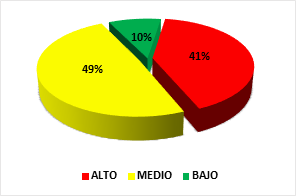Occupational health and safety to prevent occupational diseases
DOI:
https://doi.org/10.56926/unaaaciencia.v1i1.12Keywords:
occupational disease, occupational health, safety, systemAbstract
This research addresses the identification and assessment of occupational health and safety to prevent occupational diseases in workers of the Moyobamba Health Network. It was of a non-experimental type, based on the observation of phenomena as they occur in their natural context and then making the respective analysis. To collect the information, the survey was used as a technique and the questionnaire as the main instrument, the sample was 51 workers from the administrative headquarters, to diagnose the risk factors through the perception of the workers and an IPER matrix to identify the dangers and assess the risks. The results showed that the health services network presented 59 potential dangers, of which 27 of them are of important assessment, 22 of moderate assessment and 10 of tolerable assessment; The areas with the greatest probability of an incident being the Office of Sanitary Planning and Intelligence and Collective Health. Likewise, according to the risk factors of a higher level, we have physical, chemical, ergonomic, chemical and mechanical risk.
Downloads
References
Álvarez Guadalupe, G. (2015). Diseño de un Sistema de Gestión en Seguridad y Salud en el trabajo para la República del Perú [Universidad San Francisco de Quito]. http://repositorio.usfq.edu.ec/handle/23000/5662
Gómez Godoy, O. F. (2016). Percepción de los trabajadores acerca de la seguridad en el trabajo en una empresa del sector de gas natural en Casanare [Universidad del Rosario]. http://repository.urosario.edu.co/handle/10336/12766
Hernández Macías, C. (2014). Integración de la gestión de la seguridad y salud en el trabajo en la responsabilidad social. Estudio de caso en cinco empresas bogotanas [Universidad Nacional de Colombia]. https://repositorio.unal.edu.co/handle/unal/54640
ISOTools Excellence Perú. (2021). Identificación de peligros, evaluación y valoración de riesgos en un SG-SST. Plataforma Tecnológica para la Gestión de la Excelencia. https://www.isotools.org/2016/09/27/identificacion-peligros-evaluacion-valoracion-los-riesgos-sg-sst/
Licas Chávez, C. M. (2015). Sistema de gestión de seguridad y salud en el trabajo en conformidad a la ley 29783 y la norma aplicable del sector en una empresa de generación eléctrica [Universidad Nacional de Ingeniería]. http://cybertesis.uni.edu.pe/handle/uni/2517
Menéndez Díez, F. (2008). Higiene industrial. Manual para la formación del especialista (9.a ed.). Lex Nova.
Mosqueira Arce, H. (2016). Diseño de sistema de gestión de seguridad y salud en el trabajo para industria de plásticos - Procomsac - en Chiclayo [Universidad Nacional de Trujillo]. http://dspace.unitru.edu.pe/handle/UNITRU/2966
OIT. (2008). Directrices relativas a los sistemas de gestión de la seguridad y la salud en el trabajo, ILO-OSH 2001 (2.a ed.). Organización Internacional del Trabajo. https://www.ilo.org/global/topics/safety-and-health-at-work/normative-instruments/WCMS_112582/lang--es/index.htm
OIT. (2011). Sistema de gestión de la SST: una herramienta para la mejora continua (1.a ed.). Organización Internacional del Trabajo.
Rivera Rodríguez, G. G., Salazar Villacrés, J. R., & Viteri Espín, D. P. (2017). Diseño de un sistema de control operacional para una empresa dedicada a la fabricación de plásticos alineado a sart [Universidad Nacional de Trujillo]. http://www.dspace.espol.edu.ec/xmlui/handle/123456789/38649
Ruiz Conejo, C. L. M. (2011). Propuesta de un plan de seguridad y salud para obras de construcción [Pontificia Universidad Católica del Perú]. http://hdl.handle.net/20.500.12404/181
Vásquez Ojeda, M. A. (2016). Implantación de un sistema de gestión de seguridad y salud ocupacional en el proyecto especial olmos - tinajones, Lambayeque [Universidad Nacional de Trujillo]. http://dspace.unitru.edu.pe/handle/UNITRU/2967

Published
How to Cite
Issue
Section
License
Copyright (c) 2022 Juan Luis Ruiz-Aguilar

This work is licensed under a Creative Commons Attribution 4.0 International License.
The authors retain their rights:
a. The authors retain their trademark and patent rights, as well as any process or procedure described in the article.
b. The authors retain the right to share, copy, distribute, execute and publicly communicate the article published in the scientific journal UNAAACIENCIA-PERÚ (for example, place it in an institutional repository or publish it in a book), with an acknowledgment of its initial publication in UNAAACIENCIA-PERU.
c. Authors retain the right to make a subsequent publication of their work, to use the article or any part of it (for example: a compilation of their works, notes for conferences, thesis, or for a book), provided that they indicate the source. of publication (authors of the work, magazine, volume, number and date).







